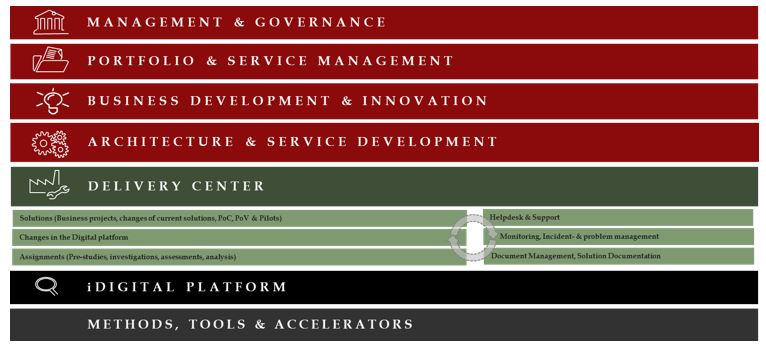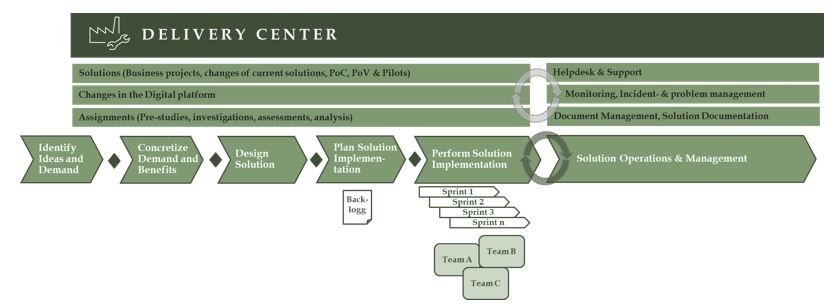THE ISERVICE CENTER, A CONCEPT FOR EXCELLENCE IN INFORMATION MANAGEMENT
January 10, 2019
In my role as Swedish lead for Business Information Management and BI & Analytics, I spent much time exploring frameworks, tools, and methodologies within Capgemini group.
On concept, I early fell for was BISC, Business Information Service Center, a conceptual framework and model with the objective to make development of information-oriented services a lot more efficient and quality driven than normally today. It later changed the name to Business Insights Service Center.
The name doesn’t matter. The “i” can be Intelligence, Integration, Insights or Information, simply iService Center. The model suits all areas where data and information are supposed to be handled as a strategic asset and with a high degree of professionalism.
The model, of course, works best if it is adapted to the characteristics, processes and culture in the organization where it is implemented.
I have had the pleasure of adapting it to the Business Intelligence business at a public agency in Sweden. I will present it shortly and dive into some areas I see as extra interesting in later blog posts.
The actual high-level view of the model looks like this.

Figure: Business Intelligence Service Center adapted for a public agency
At a first glance, the overall structure may be interesting. It contains focus areas or capability areas if you like.
Management & Governance is the area where the Steering Committee works. They create and maintain steering material and they pass steering document from other parties, like the CIO office.
One of the strongest sides of iSC is that it in large-scale DevOps style handles New Developments, Operations, Changes, Assignment services and Support in one model. Portfolio & Service Management is the management of the complete center. A portfolio is two folded. One side contains all applications that are under applications management. The other side contains of delivery demand and activities of different sizes, covering the life-cycle from ideas to phase-out of applications, as well as pre-study assignments and services like Innovation workshops.
Business Development & Innovation concludes of business development and innovation as a driving mechanism. The original model stated just Innovation, but organizations which haven’t a structured business development process have to put a focus on that before, or as a foundation for innovation.
Architecture & Service Development was called Central Design in the original model. Architecture is in Sweden a valid term for central design. What we design centrally is basically solution services, so the driving business side of Architecture is to develop solution services that has a leverage and potential to be used by many business units over the enterprise. To design common solution services is the ultimate conceptual architecture work.
Delivery Center is an organization and processes that cover both development and changes under application management. It also covers Poc/PoV development for Innovation purposes, as well as assignment services like running innovation workshops, investigation problems from problem management, performing pre-studies of different kinds and providing trainings.
One very important thing for the Delivery center is the demand/change process. In this actual case, it was defined as the following as an adaption to their common change process.

In this case, and most other, the solution implementation is done in an agile fashion. The planning for implementation is deploying solution cases to different Teams and creating a sprint plan harmonized with the actual capacity.
Another thing we added to move the development focus and development towards the business was the Identify Ideas and demand step. In this process step, the business is supposed to work structured with business development. The iSC offer assignment services to catalyze and support the business development, and in this specific case from Business Intelligence perspective. Example of assignment services are Innovation Workshop, Inspiration Workshop and Proof of Concept.
iDigital Platform is the complete technology platform used for the iSC:s complete service catalog. When looking at this specific case within Business Intelligence the platform contains of the following logical components:
| · Integration
· ETL · DW · DataLake · Data Catalogue · BI Portal
|
· Self Service toolkit
· Machine Learning · Analysis Service · Reporting Service
|
Why iSC?
I often get the question about what the difference is from any Application Management case. The first answer is that it depends on how Application Management is implemented. Another answer is that it really puts together projects, changes and incidents under one umbrella, creating synergies. Another answer is that it enables a more dynamic capacity handling as it is open to distributed teams as a starting point. In some cases, the value is just re-organization of what has been done well just to get a refresh and slight development. In the actual case for the public agency, it was used as a framework for strategy and transformation. It really points out all areas that are important from a strategic perspective. It also drives action in areas which is important but often weak in many service deliveries today; Architecture, Innovation, Service development.
Next: A deeper look into the capability areas…

 English | EN
English | EN 